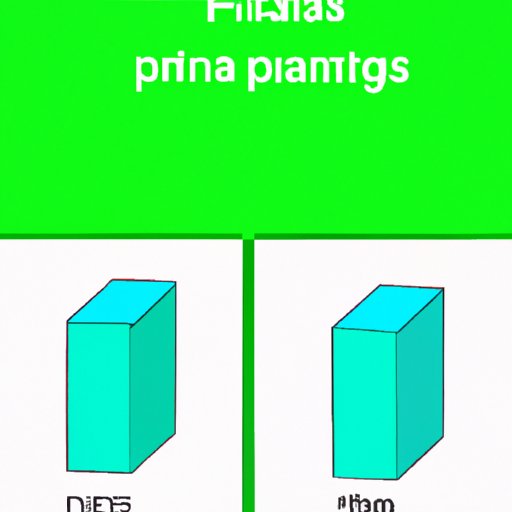Introduction
When it comes to mathematics, finding the volume of a rectangular prism is an important skill that is used in everyday life. Whether you are calculating the amount of water that can fit in a tank, or the amount of space a suitcase can hold, being able to find the volume of a rectangular prism is a fundamental skill that can come in handy. The purpose of this article is to provide a beginner’s guide and tips on how to solve for the volume of rectangular prisms.
A Beginner’s Guide to Calculating the Volume of a Rectangular Prism
A rectangular prism is a three-dimensional object that has six rectangular faces. It is also known as a rectangular cuboid. The volume of a rectangular prism is the amount of space it encloses, or the amount of liquid it can hold. This is determined by multiplying the length, width and height of the prism. The formula for calculating the volume of a rectangular prism is:
Volume = Length x Width x Height
For example, if a rectangular prism has a length of 5 cm, a width of 3 cm, and a height of 2 cm, the volume can be calculated as follows:
Volume = 5 cm x 3 cm x 2 cm = 30 cm3
It is important to note that the units used to measure the length, width and height must be the same. For example, if the length is measured in centimeters, then the width and height should also be measured in centimeters.
To remember the formula for calculating volume, a simple acronym could be used – ‘LWH’ which stands for Length, Width and Height. This makes it easier to remember the order in which the measurements need to be multiplied.
Mastering the Art of Finding Volume: Tips and Tricks for Rectangular Prisms
One of the most common mistakes people make when finding the volume of a rectangular prism is mixing up the units of measurement. To ensure accuracy in calculations, it is important to double-check the measurements and confirm that they are all in the same units before using the formula.
Another common mistake is forgetting to include the units when giving the answer. Always include the appropriate units when giving the final answer, such as cm3 or m3.
To make finding volume easier and quicker, there are certain tricks that you can use. For example, if two sides of the prism are equal in length, then multiplying them together will give the area of the base. This can be multiplied by the height to give the volume. Similarly, if the height of the prism is equal to one of the sides, then multiplying the area of the base by the height will also give the volume.
Excel at Mathematics: Understanding and Solving for the Volume of a Rectangular Prism
Finding volume is an important skill that is used in mathematics as well as in real life. It is used in geometry, physics and engineering to solve complex problems. For example, architects use the volume of rooms to determine the amount of materials needed for construction. Scientists use the volume of liquids to make accurate measurements in experiments.
There are also more complex problems that require the calculation of volume of irregular shapes. To solve these types of problems, break the shape down into smaller rectangular prisms and calculate the volume of each one. The volumes can then be added together to give the total volume of the irregular shape.
Another useful technique is to use the Cavalieri’s Principle, which states that if two solids have equal heights and equal areas of intersection with planes parallel to their bases, then they have the same volume. This means that the volume of a pyramid can be calculated by multiplying the volume of a rectangular prism with the same base and height by one-third.
Unlocking the Formula for Finding the Volume of a Rectangular Prism
The formula for finding the volume of a rectangular prism is based on the relationship between the length, width and height of the prism. The volume is equal to the product of the length, width and height because each rectangular face of the prism has the same area, which is equal to the length multiplied by the width. The height of the prism is the third measurement that determines the total volume of the prism.
The formula can be expressed algebraically as:
V = lwh
where V is volume, l is length, w is width and h is height. This formula can be used for any rectangular prism regardless of the measurements used.
Get Ahead in Math Class: An Easy Step-by-Step Guide to Finding the Volume of a Rectangular Prism
To find the volume of a rectangular prism, follow these steps:
- Measure the length, width and height of the rectangular prism in the same unit of measurement.
- Multiply the length, width and height together using the formula: V = lwh.
- Write the final answer with the appropriate units of measurement (such as cm3).
To make it easier to remember the formula, use the acronym ‘LWH’ to represent the three measurements. Always double-check that the units of measurement used for each measurement are the same before using the formula.
It is also helpful to practice solving different examples of rectangular prisms to build confidence in the skill. Using visual aids such as diagrams or photos can also help in understanding and visualizing the concept.
Conclusion
In conclusion, finding the volume of a rectangular prism is an important skill that has a variety of real-life applications. Whether for calculating the capacity of a water tank, or for determining the amount of materials needed for construction, mastering this skill is fundamental. Remember to always double-check the units of measurement used, apply tricks to make calculations easier, and practice with different examples to improve your skills. With this beginner’s guide, you can confidently find the volume of any rectangular prism that comes your way.
